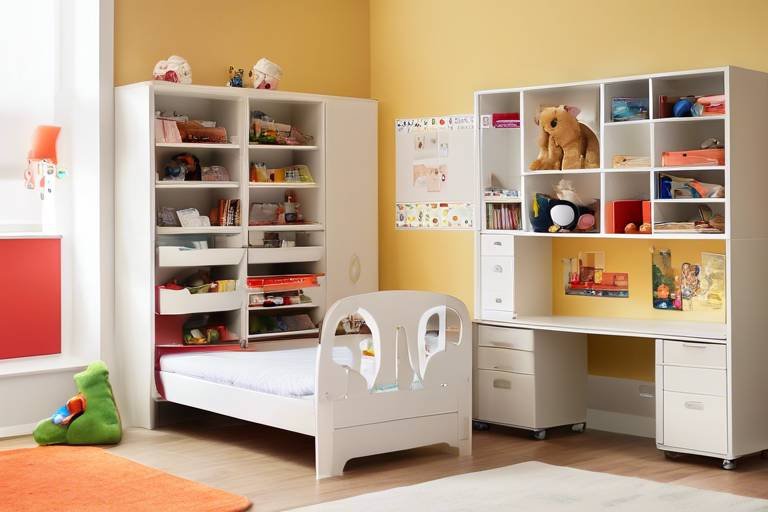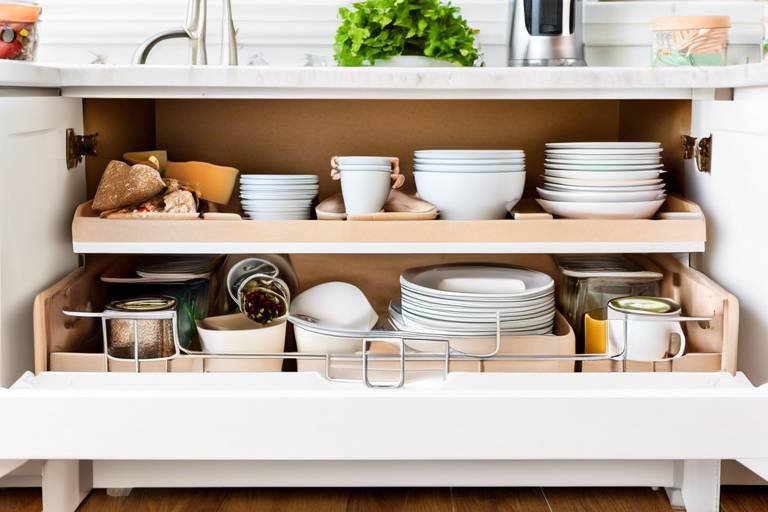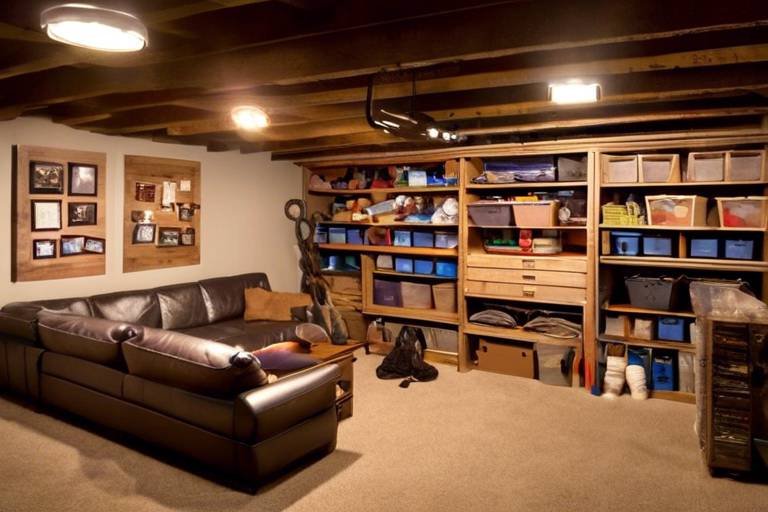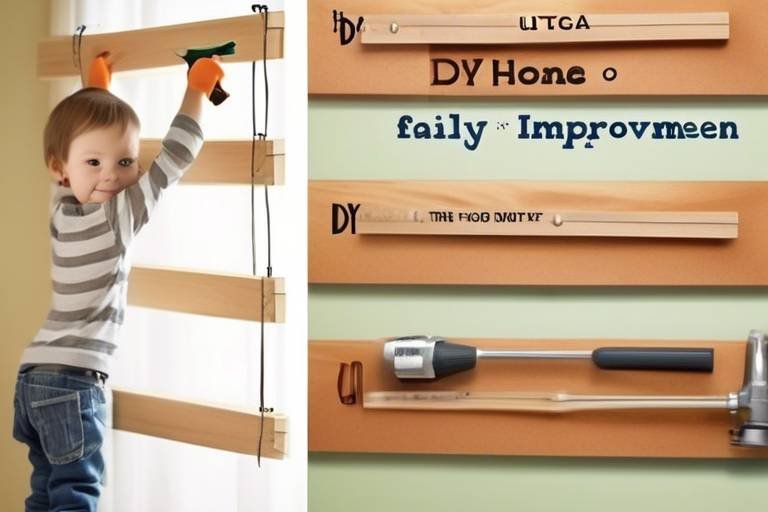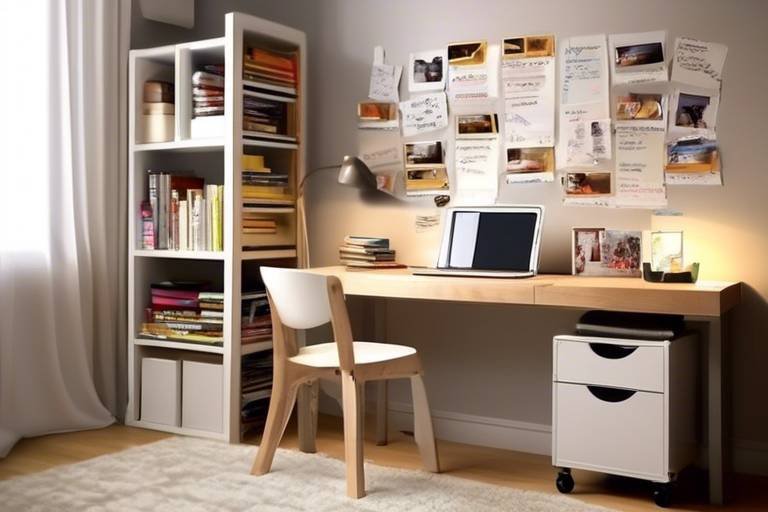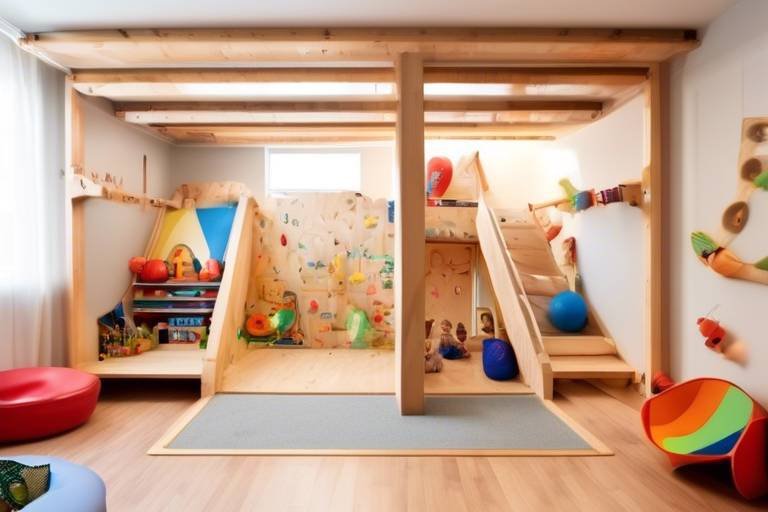Tricks to Keep Your Busy Family Home Neat
In today's fast-paced world, maintaining a tidy home can feel like an uphill battle, especially for busy families. Between work, school, extracurricular activities, and social commitments, finding the time and energy to keep your living space organized can be overwhelming. However, with a few clever strategies and a sprinkle of creativity, you can transform your chaotic home into a neat and welcoming sanctuary. This article explores effective strategies for maintaining a tidy home amidst the chaos of family life, offering practical tips and innovative solutions for busy households.
Creating a consistent cleaning schedule can help manage household chores effectively, ensuring that tasks are completed regularly and reducing the overall mess in your home. Think of your cleaning routine as the backbone of your household; without it, everything can quickly turn into a disorganized jumble. Start by identifying daily, weekly, and monthly tasks. For example, daily tasks might include making the beds, doing the dishes, and wiping down counters, while weekly tasks could involve vacuuming, dusting, and laundry. By breaking these chores into manageable chunks, you can create a routine that feels less like a chore and more like a habit.
Implementing decluttering techniques can significantly enhance your living space. Decluttering isn't just about tossing things out; it's about making thoughtful decisions regarding what you truly need and what can be let go. Start by identifying items to keep, donate, or discard, making your home more organized and less overwhelming. You might be surprised at how much space you can free up! Consider using the one-year rule: if you haven't used it in the past year, it might be time to say goodbye.
Focusing on one room at a time allows for manageable decluttering sessions, making the process less daunting and more achievable for busy families. Imagine tackling your home like a puzzle; if you try to do it all at once, it can be frustrating. Instead, dedicate a weekend to each room, setting a timer for a focused decluttering session. You'll be amazed at how much progress you can make in just 30 minutes!
Engaging all family members in the decluttering process fosters teamwork and teaches children valuable organizational skills, making it a fun and collaborative activity. Turn decluttering into a game by setting challenges, like who can fill the most donation bags in 15 minutes. Not only does this make the process enjoyable, but it also instills a sense of responsibility in your children. After all, teamwork makes the dream work!
Adopting a seasonal approach to decluttering can help maintain organization throughout the year, ensuring that items are regularly assessed and unnecessary belongings are removed. Think of it as a refreshing seasonal cleanse for your home. At the start of each season, go through your belongings and determine what you still use and love. This not only keeps your space tidy but also allows you to enjoy the things that truly matter.
Utilizing effective storage solutions can maximize space and keep items organized. Explore various options that cater to different rooms and family needs. For instance, consider using under-bed storage boxes for seasonal clothing or installing shelves in closets to utilize vertical space. The right storage solutions can turn cluttered corners into organized havens, making your home feel more spacious and inviting.
Designating specific areas for different activities can help maintain order. Establishing zones for homework, play, and relaxation can streamline daily routines and reduce clutter. Think of your home as a well-orchestrated symphony, where each section plays its part in harmony. For example, create a cozy reading nook in the living room or a dedicated homework station in a quiet corner. This not only helps everyone know where to focus but also keeps the rest of the house free from distractions.
Incorporating vertical storage options, such as shelves and hooks, can free up floor space and create a more organized environment for busy families. Vertical storage is like a magician's trick—by looking up, you can maximize your space! Install hooks for bags and jackets near the entrance or use tall bookshelves to store books and decorative items. This not only keeps things off the floor but also adds an aesthetic appeal to your home.
Investing in multi-functional furniture pieces can provide additional storage and utility, making it easier to keep your home neat while accommodating family activities. Think of a coffee table that doubles as storage or a sofa bed for guests. These pieces are like Swiss Army knives for your home—versatile and space-saving. They allow you to keep everything organized without sacrificing style or comfort.
Q: How often should I declutter my home?
A: It's a good idea to declutter at least once every season, but you can also do it more frequently as needed. Regular decluttering helps maintain a tidy space.
Q: What should I do with items I no longer need?
A: Consider donating gently used items to local charities, selling them online, or recycling them if possible. This helps reduce waste and can benefit others in your community.
Q: How can I involve my kids in cleaning and organizing?
A: Make it fun! Turn cleaning into a game, set challenges, or create a reward system for completing chores. This teaches responsibility while keeping your home tidy.

Establishing a Cleaning Routine
Creating a consistent cleaning schedule can feel like trying to tame a wild beast in a chaotic family home, but it's a game-changer! Imagine waking up to a space that feels fresh and inviting instead of a battlefield of toys, dishes, and laundry. The key to achieving this lies in establishing a cleaning routine that works for everyone. It’s not just about cleaning; it’s about creating a lifestyle where tidiness becomes second nature.
First off, let’s talk about the magic of consistency. By designating specific days for particular tasks, you can manage household chores effectively and ensure that nothing falls through the cracks. For example, you might decide that Mondays are for vacuuming, Wednesdays are for dusting, and Fridays are dedicated to laundry. This way, everyone knows what to expect, and it becomes a part of the family rhythm. You can even create a cleaning calendar that hangs on the fridge, acting as a visual reminder for everyone in the family.
Now, you might be wondering, “How do I get everyone on board?” This is where the fun begins! Involving the whole family in the cleaning routine not only lightens the load but also teaches valuable life skills. Assign age-appropriate tasks to each family member. For instance, younger kids can handle simple jobs like putting away their toys or wiping down surfaces with a damp cloth, while older kids can take on more responsibility, such as vacuuming or washing dishes. This teamwork not only fosters a sense of responsibility but also turns cleaning into a bonding activity. You might even crank up some music and make it a cleaning party!
To make your routine even more effective, consider using a cleaning checklist. This can be a simple chart that outlines daily, weekly, and monthly tasks. Here’s a quick example of what that might look like:
| Frequency | Task |
|---|---|
| Daily | Make beds, wash dishes, wipe down kitchen counters |
| Weekly | Vacuum and mop floors, clean bathrooms, dust surfaces |
| Monthly | Deep clean appliances, wash windows, organize closets |
By breaking down the cleaning tasks into manageable chunks, it becomes less overwhelming. Plus, seeing tasks checked off a list can be incredibly satisfying! But remember, flexibility is key. Life with a busy family can be unpredictable, so if something doesn’t get done on schedule, don’t stress. Just adjust and keep moving forward.
Lastly, let’s not forget the importance of rewarding yourself and your family for a job well done. After a week of sticking to the cleaning routine, celebrate with a family movie night or a special treat. This not only reinforces the positive behavior but also makes everyone feel appreciated for their efforts. In the end, establishing a cleaning routine isn’t just about keeping your home neat; it's about creating a happier, more organized family environment where everyone can thrive.
- How long should a cleaning routine take? It depends on your family size and the size of your home, but aim for about 30 minutes each day for daily tasks.
- What if my kids resist cleaning? Make it fun! Use games or music to turn cleaning into an enjoyable activity.
- Can I adjust the routine? Absolutely! Flexibility is important. Adjust your schedule as needed to fit your family’s lifestyle.

Decluttering Strategies
When it comes to keeping your home neat, decluttering is an essential strategy that can transform your living space from chaotic to calm. Imagine walking into your home and feeling an immediate sense of peace instead of being overwhelmed by clutter. That's the power of decluttering! But where do you start? The key is to implement effective techniques that allow you to sort through your belongings without feeling stressed.
First things first, a good decluttering strategy begins with identifying what to keep, donate, or discard. This can be a daunting task, but breaking it down into manageable steps makes it easier. Consider using the Four-Box Method which involves labeling four boxes: Keep, Donate, Trash, and Relocate. As you go through each room, place items into the appropriate box. This method not only helps you make decisions but also keeps the process organized. Plus, it gives you a visual representation of what you're holding onto and what can be let go.
Another effective approach is room-by-room decluttering. Instead of tackling the entire house at once, focus on one room at a time. This strategy makes the task feel less overwhelming and allows you to see progress quickly. For instance, start with the living room, where the family gathers. Clear out old magazines, toys that have lost their charm, and any decorative items that no longer fit your style. Once that room feels fresh, move on to the next. You’ll be amazed at how motivating it is to see each space transform!
Decluttering doesn't have to be a solo mission. Involve the entire family! Engaging everyone in the decluttering process fosters teamwork and teaches children valuable organizational skills. Make it a fun activity by setting a timer and seeing who can fill their box the fastest. You could even turn it into a friendly competition with small rewards for the most items donated or discarded. When everyone contributes, the decluttering process becomes a shared responsibility rather than a chore, and the family learns the importance of maintaining a tidy home together.
Don't forget about seasonal decluttering. Adopting a seasonal approach can help you maintain organization throughout the year. For instance, as the seasons change, take the opportunity to reassess your belongings. In spring, you might find winter clothes that can be donated, while in fall, you could evaluate summer toys and outdoor gear. This regular check-in keeps clutter at bay and ensures that your home remains a welcoming space for everyone.
In conclusion, decluttering is not just about tossing things away; it's about creating a more organized and peaceful living environment. By using effective strategies like the Four-Box Method, room-by-room focus, family involvement, and seasonal assessments, you can reclaim your space and enjoy the benefits of a tidy home. So, roll up your sleeves and get ready to transform your home into a haven of calm!
- How often should I declutter my home? It's recommended to do a thorough decluttering session at least twice a year, but seasonal check-ins can help keep clutter under control.
- What should I do with items I want to donate? Look for local charities or organizations that accept donations. Many will even pick up items from your home!
- How do I get my kids involved in decluttering? Make it a fun game! Set a timer and challenge them to find a certain number of items to donate, or let them choose a reward for their efforts.

Room-by-Room Decluttering
When it comes to decluttering your home, taking a room-by-room approach can be a game changer. Instead of feeling overwhelmed by the thought of tackling the entire house in one go, focusing on one room at a time allows you to break the task into manageable chunks. Think of it like eating a giant pizza; you wouldn’t try to shove the whole thing in your mouth at once, right? You’d take it slice by slice. Similarly, decluttering room by room makes the process feel less daunting and much more achievable, especially for busy families.
Start with the room that seems to accumulate the most clutter. For many, this is the living room or the kids' playroom, where toys and miscellaneous items seem to multiply overnight. As you enter the room, take a few moments to observe what stands out as clutter. Is it an overflowing toy box? Piles of magazines? Or maybe that pile of shoes by the door that seems to have taken on a life of its own? A good strategy is to set a timer for 15-30 minutes and see how much you can accomplish in that time. You might be surprised at how much you can clear away in a short burst of focused effort.
While decluttering, it’s essential to have clear categories in mind for sorting items. You can create three main piles: keep, donate, and discard. This method not only helps you make decisions but also simplifies the process. For instance, as you sift through toys, ask yourself: “Is this toy played with regularly, or is it just taking up space?” If it’s not being used, it might be time to let it go. You can also involve your kids in this process, teaching them the value of sharing by donating toys they no longer play with.
Once you’ve tackled one room, take a moment to celebrate your progress. Maybe treat yourself to a cozy movie night in your newly decluttered space or enjoy a cup of tea in your clean kitchen. It’s important to recognize your efforts; decluttering is not just about cleaning—it's about creating a space that feels good to be in.
As you continue this room-by-room journey, consider adopting a systematic approach. You might want to create a checklist of rooms to declutter, like so:
| Room | Status |
|---|---|
| Living Room | ✔️ Completed |
| Kitchen | ❌ Pending |
| Bedroom | ❌ Pending |
| Playroom | ❌ Pending |
By tracking your progress, you’ll not only stay motivated but also see how far you’ve come. Remember, decluttering doesn’t have to be a one-time event. Make it a regular part of your family routine. Perhaps consider a seasonal decluttering day where everyone pitches in to keep the home tidy. This way, you can maintain order and ensure that clutter doesn’t creep back in.
In summary, the room-by-room decluttering method is a practical and effective strategy for busy families. It allows you to take control of your space, reduce stress, and create a more organized and inviting home. So grab that timer, gather your family, and start your decluttering adventure today!
Q: How often should we declutter our home?
A: It’s beneficial to declutter at least once a season, but you can also do smaller decluttering sessions monthly or even weekly to keep things in check.
Q: What should I do with items I decide to donate?
A: Research local charities or organizations that accept donations. Many will even pick up items directly from your home!
Q: How do I get my kids involved in decluttering?
A: Make it a fun activity! Set a timer and see who can fill a box with the most items to donate. Reward them afterward with a small treat or activity.

Involving the Family
Getting the entire family involved in the decluttering process is not just a smart move; it’s also a fantastic way to bond and teach essential life skills. Think of it as a team sport where everyone has a role to play. When you include your kids in the process, they learn the value of organization and responsibility, all while having a little fun. You can turn this chore into a game by setting a timer and seeing who can declutter the most items in a given time frame. This not only makes the task feel less like a chore but also encourages a little friendly competition!
To kick things off, gather everyone in the living room or a central space and explain the importance of decluttering. Discuss how a tidy home can lead to a happier environment. You might say something like, “When our home is neat, we can find our toys and books easily, and we’ll have more space to play!” This sets a positive tone and gets everyone on board.
Next, you can assign specific tasks based on age and ability. For instance, younger kids can be responsible for sorting through their toys, while older children can tackle their closets or even help with shared family spaces. By breaking down the process into manageable tasks, you’ll prevent the overwhelming feeling that often comes with decluttering. You might even create a simple chart to track progress, showing how many items each person has decluttered. This visual representation can be incredibly motivating!
Don’t forget to celebrate your family’s hard work! After completing a decluttering session, consider rewarding the team with a fun family activity—maybe a movie night or a trip to the park. Celebrating achievements, no matter how small, reinforces positive behavior and encourages everyone to participate next time.
Involving the family in decluttering not only helps maintain a tidy home but also strengthens family bonds. It teaches children valuable lessons about responsibility, teamwork, and the importance of maintaining a pleasant living space. So, rally your troops, put on some upbeat music, and turn decluttering into a family affair!

Seasonal Decluttering
Adopting a seasonal approach to decluttering can be a game-changer for busy families. Imagine the satisfaction of welcoming each new season with a fresh start, free from the clutter that tends to accumulate over time. Just like you change your wardrobe with the seasons, your home deserves the same attention. The idea is simple: set aside a specific time each season to evaluate what you have and what you truly need. This not only keeps your space organized but also creates a habit of regularly assessing your belongings.
To make seasonal decluttering effective, consider creating a checklist that you can follow each time. This checklist can include items that are often overlooked, such as:
- Clothes that no longer fit or are out of style
- Toys that your children have outgrown
- Kitchen gadgets that you never use
- Books that have been collecting dust
As you go through each room, ask yourself a few key questions: When was the last time I used this? or Does this item bring me joy? These questions not only help in making decisions but also encourage a mindful approach to your possessions. You might be surprised at how many items can be easily categorized as 'donate' or 'discard.'
To streamline the process, consider designating specific days for each room or category of items. For instance, you might tackle the living room one weekend and the children's playroom the next. This way, you won't feel overwhelmed, and the process becomes more manageable. Additionally, involving your family members can turn this chore into a fun activity. You could even make it a game to see who can find the most items to donate!
Remember, seasonal decluttering isn't just about getting rid of things; it's about making space for what truly matters. As you clear out the old, you're also creating a welcoming environment for new memories and experiences. Plus, when you maintain this habit, you'll find that your home feels lighter and more organized, making it easier to enjoy family time without the distraction of clutter.
Q: How often should I declutter my home?
A: Ideally, you should aim to declutter seasonally. However, if you notice clutter building up, don’t hesitate to tackle it sooner!
Q: What should I do with items I no longer want?
A: Consider donating them to local charities, selling them online, or recycling them if they're no longer usable.
Q: How can I involve my children in the decluttering process?
A: Make it a fun game! Set a timer and see who can find the most items to donate or create a reward system for their participation.
Q: What if I feel guilty about getting rid of things?
A: It's normal to feel that way, but remember that holding onto items you don’t use takes up valuable space. Focus on the joy of making room for things you truly love and use.

Storage Solutions
When it comes to keeping your busy family home neat, play a pivotal role. Imagine your home as a puzzle; every piece needs to fit just right to create a beautiful picture. By utilizing effective storage options, you can maximize your space and keep everything organized, which is especially crucial for families where chaos often reigns supreme. Let’s dive into some innovative ideas that can transform your living space into a harmonious environment.
First and foremost, consider the importance of vertical space. Many families overlook the walls in their homes, but they can be your best friend when it comes to storage. Installing shelves high up can free up valuable floor space, allowing for a more open and airy feel. Think of it this way: your floors are like the foundation of a house; the walls can be the pillars that support your organizational efforts. By adding shelves, you can store books, toys, and decorative items without cluttering surfaces.
Next, let’s talk about multi-functional furniture. In a busy household, every piece of furniture should earn its keep. Investing in items that serve more than one purpose can be a game changer. For example, a coffee table with hidden storage can hold board games or blankets, while a sofa bed can provide extra sleeping space for guests without taking up additional room. This approach not only saves space but also adds a touch of creativity to your home. You can think of multi-functional furniture as the Swiss Army knife of home decor—versatile and practical!
Another innovative storage solution is incorporating under-bed storage. This often-overlooked area can be a treasure trove for keeping your home organized. Utilizing bins or drawers that slide under your bed can help store out-of-season clothing, shoes, or even toys that your kids no longer play with regularly. It’s like having a secret compartment that keeps things out of sight but still easily accessible when you need them. Plus, it’s a great way to maximize every inch of your home.
Moreover, consider using clear storage bins for your items. These bins can be stacked and labeled, making it easy for everyone in the family to find what they need. When you can see what’s inside, it reduces the chances of buying duplicates and keeps your space clutter-free. You can even involve your kids in this process—let them decorate their own bins! This not only helps them learn about organization but also adds a personal touch to their storage solutions.
Lastly, let’s not forget about the power of hooks and pegboards. These can be installed in various areas of your home, from entryways to kitchens, and can hold anything from bags and coats to kitchen utensils and tools. Hooks are like the superheroes of storage; they can transform a messy area into an organized one in no time. Plus, they add a fun, eclectic vibe to your decor.
In summary, effective storage solutions are essential for maintaining order in a busy family home. By utilizing vertical space, investing in multi-functional furniture, making use of under-bed storage, opting for clear bins, and incorporating hooks and pegboards, you can create a living space that is not only neat but also functional. Remember, the goal is to create an environment where everything has its place, making your home a sanctuary amidst the chaos of family life.
- What are the best storage solutions for small spaces?
Utilizing vertical space, multi-functional furniture, and under-bed storage can maximize space in small areas. - How can I get my kids involved in organizing?
Let them decorate their storage bins and assign them specific areas to keep tidy, making the process fun and educational. - What types of furniture are considered multi-functional?
Examples include ottomans with storage, sofa beds, and coffee tables with compartments.

Creating Family Zones
In the hustle and bustle of family life, chaos can quickly take over your home. One effective way to combat this is by creating designated family zones throughout your living space. Think of these zones as individual islands in a sea of activity, each serving a specific purpose that helps streamline your daily routines. By allocating areas for homework, play, and relaxation, you can significantly reduce clutter and enhance productivity. It’s like giving each family member their own little corner of the world where they can thrive!
Imagine walking into your home and instantly feeling a sense of order. That’s the magic of family zones! By establishing clear boundaries for different activities, you can help your family members know where to go for what they need. For instance, a cozy nook filled with books and study materials can serve as the homework zone, while a vibrant play area with toys and games can be the play zone. This not only keeps things organized but also makes it easier for everyone to find what they’re looking for when they need it.
To further illustrate this concept, let’s take a look at a simple layout of potential family zones:
| Zone | Purpose | Key Features |
|---|---|---|
| Homework Zone | A quiet place for studying and completing assignments | Desks, bookshelves, good lighting, and study supplies |
| Play Zone | A fun area for kids to play and socialize | Toys, games, soft flooring, and seating |
| Relaxation Zone | A space for unwinding and family bonding | Comfortable seating, books, and entertainment options |
Now, let’s talk about the importance of involving your family in this process. When you engage everyone in the creation of these zones, it not only fosters a sense of ownership but also encourages them to keep their areas tidy. You might say, “Hey kids, let’s brainstorm what we need in our play zone!” This can turn into a fun family project, where everyone gets to contribute ideas and even help with the setup. Plus, it teaches children valuable lessons about organization and responsibility.
Moreover, it’s essential to regularly reassess these zones. As your family grows and changes, so do their needs. Maybe your kids will outgrow their toys, or perhaps they’ll need a larger workspace for school projects. By adopting a flexible approach to family zones, you can ensure that your home remains a comfortable and functional environment for everyone.
In conclusion, creating family zones is not just about tidiness; it’s about enhancing your family’s lifestyle. By establishing clear areas for specific activities, you can reduce clutter, improve focus, and foster a collaborative spirit. So, why not start today? Take a look around your home and envision how you can transform it into a well-organized haven that suits your family’s unique needs.
- What are family zones? Family zones are designated areas in your home set up for specific activities, such as homework, play, or relaxation.
- How can I involve my family in creating these zones? Engage your family members in discussions about what each zone should include, and allow them to help set up their spaces.
- Do family zones need to be permanent? No, family zones can be adjusted as your family’s needs change over time.
- What if I have limited space? You can still create effective family zones by utilizing vertical storage and multi-functional furniture to maximize your space.

Utilizing Vertical Space
In the hustle and bustle of family life, it’s easy to overlook the potential of your walls and ceilings. However, can be a game-changer when it comes to maintaining a tidy home. Imagine your living room, filled with toys, books, and random items scattered across the floor. Now picture those same items neatly organized on shelves and hooks, freeing up precious floor space for your family’s activities. By looking up, you can transform your home into an organized haven, allowing for more room to breathe and play.
One of the simplest ways to maximize vertical space is by incorporating wall-mounted shelves. These shelves can hold everything from books to decorative items, providing a stylish solution that keeps clutter off the ground. You can even create a mini-library by installing shelves in your children’s rooms, encouraging them to keep their books organized and easily accessible. Not only does this make the room look neater, but it also promotes a love for reading!
Another fantastic way to utilize vertical space is through the use of hooks and pegboards. These versatile tools can be installed in entryways, kitchens, or playrooms, providing a designated spot for everything from jackets to kitchen utensils. Imagine walking into your home and seeing jackets hung neatly on hooks instead of tossed on the floor. It’s not just about aesthetics; it’s about creating a functional space that works for your family. Consider using colorful hooks to make it fun for the kids, turning organization into a game!
For those who love a bit of creativity, hanging baskets can be an excellent addition to your vertical storage solutions. These can be used in the kitchen for fruits and vegetables, or in the bathroom for toiletries. Hanging baskets not only look charming but also make it easy to access items without cluttering countertops. Plus, they can be a unique decoration that adds character to your home.
Let’s not forget about the power of furniture with vertical storage. Think about investing in tall bookshelves or cabinets that take advantage of your room’s height. These pieces can store a multitude of items while keeping them out of sight. For example, a tall cabinet in the living room can house board games, craft supplies, and even blankets, all while maintaining a clean and organized appearance.
To illustrate how effective vertical space utilization can be, consider the following table that compares traditional storage methods with vertical solutions:
| Storage Method | Benefits |
|---|---|
| Traditional Shelving | Requires floor space, can be cluttered easily |
| Wall-Mounted Shelves | Maximizes vertical space, keeps items off the floor |
| Hooks and Pegboards | Easy access, encourages organization, customizable |
| Hanging Baskets | Charming decor, keeps items accessible, versatile |
| Tall Furniture | Offers ample storage without taking up much floor space |
Incorporating these vertical storage solutions into your home doesn’t have to be overwhelming. Start small, perhaps by adding a few shelves in your living room or hooks in the entryway, and gradually build your vertical storage as you see how much more space you can create. With a little creativity and effort, you’ll find that utilizing vertical space not only keeps your home neat but also enhances your family’s lifestyle.
- How can I start utilizing vertical space in my home? Begin with small changes, like adding wall-mounted shelves or hooks, and gradually expand as you see the benefits.
- What items are best suited for vertical storage? Items like books, toys, kitchen utensils, and seasonal decorations are great candidates for vertical storage solutions.
- Can vertical storage solutions be stylish? Absolutely! Many vertical storage options come in various designs and colors, allowing you to add a decorative touch to your home.

Multi-Functional Furniture
In today's fast-paced world, where family life can feel like a whirlwind, emerges as a hero in the quest for a tidy home. Imagine a coffee table that not only holds your favorite books and magazines but also transforms into a dining table when guests arrive. Or a sofa that doubles as a bed for those unexpected sleepovers. These clever pieces of furniture are not just about saving space; they are about enhancing the way we live and interact within our homes.
When choosing multi-functional furniture, think about your family's needs. Do you have kids who need a play area that can quickly convert into a study space? Consider investing in a sturdy ottoman that opens up for storage and provides extra seating during family game nights. It's like having a Swiss Army knife for your living room!
Here are some popular types of multi-functional furniture that can revolutionize your home:
- Sofa Beds: Perfect for accommodating overnight guests without sacrificing space.
- Storage Ottomans: These versatile pieces can serve as footrests, extra seating, or hidden storage for toys and blankets.
- Expandable Dining Tables: Ideal for families who love hosting dinners but need to save space during regular meals.
- Bookshelf Desks: A great solution for creating a home office nook without dedicating an entire room.
Choosing the right multi-functional furniture can also bring a sense of style to your home. Look for pieces that fit your aesthetic while serving practical purposes. For instance, a chic coffee table with built-in storage can be both a statement piece and a functional item. When everything has its place, you’ll find it easier to keep your living areas organized and clutter-free.
In addition to saving space, multi-functional furniture can also make your home feel more inviting. When your living space is well-organized, it creates a calming atmosphere that allows for better family interactions. You can enjoy movie nights without tripping over toys, and family dinners can feel more special when the dining area is neat and functional.
So, as you navigate the challenges of maintaining a busy household, consider adding multi-functional furniture to your arsenal. It’s a smart investment that not only helps keep your home tidy but also adapts to your family's ever-changing needs, making your living space a true reflection of your lifestyle.
Q: What is multi-functional furniture?
A: Multi-functional furniture refers to pieces that serve more than one purpose, such as a sofa bed that provides seating during the day and converts into a bed at night.
Q: How can I choose the right multi-functional furniture for my home?
A: Consider your family's specific needs and the space available. Look for items that complement your existing decor and offer practical solutions, like extra storage or seating.
Q: Are multi-functional furniture pieces more expensive?
A: While some multi-functional furniture can be pricier due to their versatility and design, many affordable options are available. It’s about finding the right balance between budget and functionality.
Q: Can multi-functional furniture be stylish?
A: Absolutely! Many designers create beautiful multi-functional furniture that adds to the aesthetic of your home while providing practicality.
Frequently Asked Questions
- How can I create a cleaning routine that works for my family?
Start by identifying the chores that need to be done regularly. Create a simple schedule that assigns specific tasks to certain days of the week. Involve your family in the planning process to ensure everyone is on board. Remember, consistency is key, so try to stick to your routine as much as possible!
- What are some effective decluttering strategies?
One of the best strategies is to tackle one room at a time. This makes the process feel less overwhelming. You can also categorize items into three groups: keep, donate, or discard. Make it a fun family activity by involving everyone in the process, and don’t forget to celebrate your progress!
- How often should I declutter my home?
Adopting a seasonal approach is a great way to keep your home organized. Set aside time every few months to reassess your belongings. This ensures that you’re regularly evaluating what you really need and helps prevent clutter from piling up.
- What storage solutions work best for busy families?
Utilizing vertical space is a fantastic way to maximize storage. Consider installing shelves, hooks, or pegboards in various rooms. Multi-functional furniture, like ottomans with storage or beds with drawers, can also provide extra space without sacrificing style.
- How can I create effective family zones in my home?
Designate specific areas for different activities, such as homework, play, and relaxation. Use furniture or room dividers to clearly separate these zones. This not only helps keep things organized but also makes it easier for family members to know where to go for various activities.
- What are some tips for involving my kids in the cleaning process?
Make cleaning fun by turning it into a game! Set a timer and see who can pick up the most toys in a few minutes. You can also reward them for their efforts with a small treat or extra playtime. Teaching kids organizational skills early on will benefit them for years to come!


